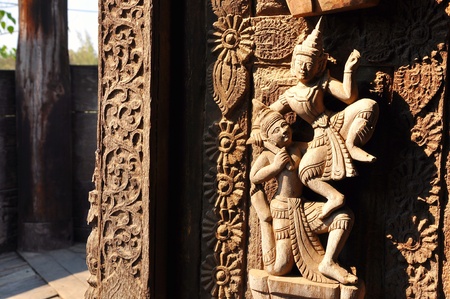Introduction to Mud Houses in Rural India
Mud houses, locally known as mitti ke ghar, are an integral part of the rural landscape across India. These humble dwellings are constructed primarily using earth, often mixed with natural binding materials like cow dung, straw, and sometimes lime. The prevalence of mud houses is especially notable in states such as Rajasthan, Uttar Pradesh, West Bengal, and Odisha, where the availability of soil and traditional expertise make this practice widespread. The construction methods vary from region to region, reflecting local climate conditions and cultural preferences. Techniques like cob, wattle and daub, and sun-dried mud bricks (adobe) have been passed down through generations, ensuring that these homes remain affordable, environmentally friendly, and well-suited to the Indian countryside. Mud houses not only provide basic shelter but also represent a harmonious relationship between people and their environment, forming a crucial aspect of rural heritage in India.
2. Historical and Cultural Roots
The tradition of building mud houses in Indian villages dates back thousands of years, forming an integral part of the subcontinent’s architectural heritage. The use of locally available earth materials is deeply woven into the lifestyle and customs of rural India, reflecting both environmental wisdom and cultural continuity. From the Harappan civilization to present-day hamlets, mud construction has evolved alongside Indian society, adapting to local climates, resources, and beliefs.
Ancient Heritage of Mud Construction
Mud houses are not merely shelters; they are symbols of adaptation and sustainability. Ancient texts and archaeological evidence reveal that earthen architecture flourished across diverse regions—from Rajasthan’s arid deserts to Assam’s flood-prone plains. The knowledge of soil selection, mixing techniques, and structural methods was passed down through generations, often guarded by specific communities or artisan groups.
Connection to Local Customs and Folklore
In many villages, the process of constructing a mud house is accompanied by rituals seeking blessings from deities like Vastu Purusha or Bhoomi Devi. These traditions highlight a harmonious relationship between people and their land. Folk songs, proverbs, and stories celebrating mud houses abound in regional languages, reinforcing their significance in community identity.
Table: Regional Variations in Mud House Traditions
| Region | Local Term | Cultural Practices |
|---|---|---|
| Rajasthan | Kuccha Ghar | Wall art with lime & natural pigments (Mandana) |
| Bihar | Mitti Ka Makaan | Decorative motifs during festivals (Chhath Puja) |
| Tamil Nadu | Mann Veedu | Mud floors polished with cow dung for auspiciousness |
| Assam | Kucha Ghar | Bamboo reinforcement for flood resistance |
This blend of practicality and symbolism ensures that mud houses remain a living legacy, representing both the resilience and the collective memory of rural India.
![]()
3. Social and Communal Aspects
Mud houses in Indian villages are not merely architectural structures; they stand as living symbols of social unity and collective identity. The process of building a mud house is deeply embedded in traditional practices, where entire communities come together to participate in every stage of construction. This collaborative effort, often described by villagers as “shramdaan,” fosters a sense of belonging and mutual support that transcends individual households.
During the construction phase, neighbours gather to share knowledge, skills, and resources. Elders pass on indigenous techniques, while younger members contribute physical labour. This intergenerational collaboration ensures that local wisdom endures and that each home reflects the unique cultural heritage of the community. Such participation strengthens interpersonal bonds and reinforces the value of teamwork, which is integral to rural Indian society.
Beyond their construction, mud houses play a vital role in everyday village life. These homes often serve as informal gathering spaces for families and neighbours during festivals, religious ceremonies, or community meetings. The cool interiors of mud houses provide respite from the harsh Indian summers, making them popular venues for social interaction and hospitality. In many regions, the verandah or “angan” becomes a communal area where women engage in household chores while exchanging stories and advice.
The maintenance of mud houses also encourages ongoing communal involvement. Annual repairs, especially before the monsoon season, are carried out collectively, further cementing relationships among villagers. This culture of cooperation not only preserves the physical integrity of these dwellings but also nurtures a spirit of togetherness essential for thriving rural communities.
4. Sustainability and Environmental Benefits
Mud houses, commonly seen in Indian villages, are renowned for their eco-friendly construction and sustainable living benefits. Unlike modern concrete structures, mud houses utilize locally available materials such as clay, straw, cow dung, and natural fibers. This not only reduces the environmental impact but also supports traditional livelihoods. The low carbon footprint of mud houses is one of their most significant advantages, as the construction process demands minimal energy and emits fewer greenhouse gases compared to conventional buildings.
Another key benefit is thermal comfort. Mud walls possess excellent insulating properties that keep interiors cool during the scorching Indian summers and warm during chilly winters. This natural temperature regulation minimizes the dependence on artificial cooling or heating systems, leading to substantial energy savings for rural households. Villagers often express their appreciation for these traditional homes with phrases like “thandi garmi ka ghar” (the house that keeps you cool and warm), reflecting deep cultural connection.
Moreover, mud houses exist in harmony with nature. They are biodegradable and can be returned to the earth at the end of their lifecycle without causing pollution. The table below highlights a comparison between mud houses and modern concrete homes in terms of sustainability:
| Aspect | Mud Houses | Concrete Houses |
|---|---|---|
| Materials Used | Locally sourced natural materials | Industrial materials (cement, steel) |
| Carbon Footprint | Low | High |
| Thermal Comfort | Excellent insulation | Poor insulation, needs AC/heating |
| Lifecycle Impact | Biodegradable | Non-biodegradable waste |
This approach not only preserves the environment but also resonates with India’s ancient wisdom of living sustainably—“Vasudhaiva Kutumbakam” (the world is one family). Thus, mud houses embody an ecological philosophy deeply rooted in Indian culture.
5. Regional Diversity in Mud House Architecture
Indias vast geographical expanse and cultural plurality have given rise to a remarkable diversity in mud house architecture across its states. Each region showcases unique approaches to construction, deeply influenced by local climate, readily available materials, and indigenous traditions. For instance, in Rajasthans arid Thar desert, mud houses are often built with thick walls and small windows to keep interiors cool during scorching summers. In contrast, the lush regions of Kerala favour mud walls mixed with laterite stone, topped with sloping tiled roofs to withstand heavy monsoon rains. The tribal villages of Odisha and Chhattisgarh are renowned for their vibrantly painted mud huts adorned with traditional motifs, reflecting the artistic inclinations of their communities. In Gujarats Kutch district, the circular bhunga houses are engineered to resist earthquakes and extreme temperatures, demonstrating adaptive ingenuity rooted in centuries-old practices. These regional differences not only highlight Indias ecological adaptation but also embody the socio-cultural identities of various communities. By examining these variations, one can appreciate how mud house architecture in Indian villages is not merely about shelter—it is a living testimony to the harmonious blend of environment, culture, and tradition.
6. Challenges and Modern Adaptations
Mud houses, while holding immense cultural significance in Indian villages, face several challenges in the contemporary era.
Urbanisation and Changing Aspirations
With rapid urbanisation and growing exposure to modern lifestyles, many rural communities are shifting towards concrete structures, perceiving them as symbols of status and durability. This shift often leads to the neglect of traditional mud houses, despite their eco-friendly and climate-responsive qualities.
Structural Vulnerabilities
Mud houses are susceptible to damage from heavy rains, floods, and termites. In regions experiencing extreme weather events due to climate change, these vulnerabilities become more pronounced. The lack of proper maintenance and technical know-how further exacerbates the problem, causing some villagers to abandon traditional practices.
Blending Tradition with Innovation
Despite these challenges, there is a growing movement among architects, NGOs, and local artisans to revive and modernise mud house construction. Innovative techniques such as stabilised mud blocks, improved roofing materials, and chemical treatments for pest resistance are being introduced. These adaptations enhance the strength and longevity of mud houses without compromising their cultural identity or sustainability.
Community-Led Solutions
Many communities are rediscovering pride in their heritage by participating in workshops on sustainable building techniques. Government schemes and non-profit initiatives now promote the use of locally available materials combined with modern engineering methods. This fusion not only addresses the practical needs of villagers but also ensures that the cultural legacy of mud houses continues for future generations.
In conclusion, while mud houses in Indian villages face significant challenges today, the blending of traditional wisdom with modern innovations offers a promising path forward—preserving both cultural values and environmental benefits.


